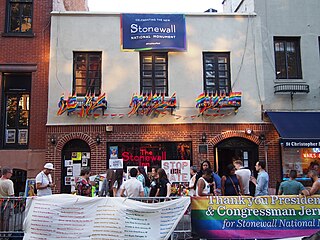
The LGBTQ community is a loosely defined grouping of lesbian, gay, bisexual, transgender, and queer or questioning individuals united by a common culture and social movements. These communities generally celebrate pride, diversity, individuality, and sexuality. LGBTQ activists and sociologists see LGBTQ community-building as a counterweight to heterosexism, homophobia, biphobia, transphobia, sexualism, and conformist pressures that exist in the larger society. The term pride or sometimes gay pride expresses the LGBTQ community's identity and collective strength; pride parades provide both a prime example of the use and a demonstration of the general meaning of the term. The LGBTQ community is diverse in political affiliation. Not all people who are lesbian, gay, bisexual, or transgender consider themselves part of the LGBTQ community.
"New queer cinema" is a term first coined by the academic B. Ruby Rich in Sight & Sound magazine in 1992 to define and describe a movement in queer-themed independent filmmaking in the early 1990s.

LGBTQ themes in speculative fiction include lesbian, gay, bisexual, transgender, or queer (LGBTQ) themes in science fiction, fantasy, horror fiction and related genres.[a] Such elements may include an LGBTQ character as the protagonist or a major character, or explorations of sexuality or gender that deviate from the heteronormative.
Bisexual chic is a phrase used to describe the public acknowledgment of bisexuality or increased public interest or acceptance of bisexuality. Another usage describes a faddish attention towards bisexuality. Bisexual chic is often accompanied by celebrities publicly revealing their bisexuality.

LGBTQ stereotypes are stereotypes about lesbian, gay, bisexual, transgender, and queer (LGBTQ) people based on their sexual orientations, gender identities, or gender expressions. Stereotypical perceptions may be acquired through interactions with parents, teachers, peers and mass media, or, more generally, through a lack of firsthand familiarity, resulting in an increased reliance on generalizations.

In comics, LGBTQ themes are a relatively new concept, as lesbian, gay, bisexual, transgender, or queer (LGBTQ) themes and characters were historically omitted from the content of comic books and their comic strip predecessors due to anti-gay censorship. LGBTQ existence was included only via innuendo, subtext and inference. However the practice of hiding LGBTQ characters in the early part of the twentieth century evolved into open inclusion in the late twentieth and early twenty-first centuries, and comics explored the challenges of coming-out, societal discrimination, and personal and romantic relationships between gay characters.

Bisexual erasure, also called bisexual invisibility, is the tendency to ignore, remove, falsify, or re-explain evidence of bisexuality in history, academia, the news media, and other primary sources.

The Watermelon Woman is a 1996 American romantic comedy-drama film written, directed, and edited by Cheryl Dunye. The first feature film directed by a black lesbian, it stars Dunye as Cheryl, a young black lesbian working a day job in a video store while trying to make a film about Fae Richards, a black actress from the 1930s known for playing the stereotypical "mammy" roles relegated to black actresses during the period.
Falcon Entertainment, a United States independent company based in San Francisco, California, is one of the world's largest producers of gay pornography.

Gay interpretations have been part of the academic study of the Batman franchise at least since psychiatrist Fredric Wertham asserted in his 1954 book Seduction of the Innocent that "Batman stories are psychologically homosexual". Several characters in the Modern Age Batman comic books are expressly gay, lesbian, or bisexual.

The first English-language use of the word "bisexual" to refer to sexual orientation occurred in 1892.
Paul Joseph Castellaneta is an American film director, who wrote and directed the films Together Alone and Relax...It's Just Sex.
Bisexual literature is a subgenre of LGBTQ literature that includes literary works and authors that address the topic of bisexuality or biromanticism. This includes characters, plot lines, and/or themes portraying bisexual behavior in both men and women.

The history of bisexuality concerns the history of the bisexual sexual orientation. Ancient and medieval history of bisexuality, when the term did not exist as such, consists of anecdotes of sexual behaviour and relationships between people of the same and different sexes. A modern definition of bisexuality began to take shape in the mid-19th century within three interconnected domains of knowledge: biology, psychology and sexuality. In modern Western culture, the term bisexual was first defined in a binary approach as a person with romantic or sexual attraction to both men and women. The term bisexual is defined later in the 20th century as a person who is sexually and/or romantically attracted to both males and females, or as a person who is sexually and/or romantically attracted to people regardless of sex or gender identity, which is sometimes termed pansexuality.





